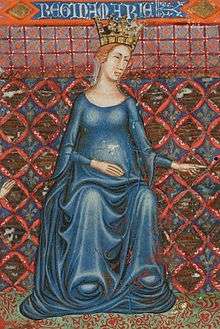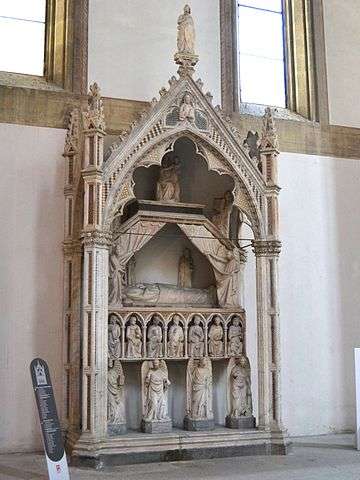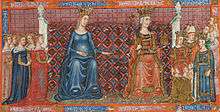Mary of Hungary, Queen of Naples
Mary of Hungary (c. 1257 – 25 March 1323), of the Árpád dynasty, was Queen consort of the Kingdom of Naples. She was a daughter of Stephen V of Hungary and his wife Elizabeth the Cuman.[1] Mary served as Regent in Provence in 1290–1294 and in Naples in 1295–96, 1296–98, and 1302, during the absences of her consort.
| Mary of Hungary | |
|---|---|
 Queen Mary from the Bible of Naples | |
| Queen consort of Naples | |
| Tenure | 1285 – 5 May 1309 |
| Born | 1257 |
| Died | 25 March 1323 (aged 65–66) Naples |
| Burial | Santa Maria Donna Regina, Naples |
| Spouse | Charles II of Naples |
| Issue | Charles Martel of Anjou Louis of Toulouse Robert of Naples Philip I, Prince of Taranto Raymond Berengar of Andria Peter Tempesta John, Duke of Durazzo Margaret, Countess of Anjou and Maine Blanche, Queen of Aragon Eleanor, Queen of Sicily Maria, Queen of Majorca Beatrice, Countess of Andria |
| Dynasty | Árpád |
| Father | Stephen V of Hungary |
| Mother | Elizabeth the Cuman |
Family
Mary's mother followed the Shamanist religion, like other Cumans. She was considered a Pagan by contemporary Christians of Europe and Elizabeth had to convert to Catholicism in order to marry Maria's father, Stephen. It's unknown at what age she chose Christianity, but could be possible that she was already raised as an Orthodox in the Hungarian royal court since her childhood.
Mary was the second of six children. Her sisters, Elizabeth and Catherine both became Queen of Serbia. Another sister, Anna married Andronikos II Palaiologos. Mary's only brother was Ladislaus IV of Hungary.
Her paternal grandparents were Béla IV of Hungary and his wife Maria Laskarina. Her maternal grandparents could have been Köten, leader of a tribe of Cumans and an unknown mother.
Life
In 1270, when Mary was only twelve years of age, she married the future Charles II of Naples.[1] The wedding took place in Naples on 6 August 1270. The marriage was intended as a double alliance between Naples and Hungary to support the intended conquest of Byzantium by Naples, but it did not serve its purpose as her brother in 1272 made an alliance with Byzantium as well. Maria accompanied Charles on his trips and spent 1278-82 in Provence with her consort. In 1284, she made her first political act: when Charles was taken captive by Aragon, she made the decision to free the Aragonese prisoner Beatrice of Hohenstaufen. In 1285, Charles became monarch but remained in Aragonese prison. She did not take part in the regency for him in Naples, but remained in Provence, where she did take part in the administration from time to time, though she was not formal regent. In 1288, she took part in the negotiations of her consort's release, and the same year, she made a peace treaty with Aragon. Charles was released the same year, and they returned to Naples together. In 1290-94, she was regent for him in Provence.

On 10 July 1290, Mary's brother, Ladislaus IV of Hungary died childless. The question now was who would succeed him: he had four sisters, three of them outlived him, all four had married powerful rulers and all four had their own children. On 21 September 1290, Mary claimed the throne of Hungary. She was up against her two sisters, Catherine and Elisabeth, and their children, plus the children of her younger sister Anna. The Pope confirmed her sole rights in Hungary on 30 August 1295. However, Catherine's son, Stephen Vladislav II of Syrmia, was still a dangerous rival for Mary and Charles Martel. In the end, Charles Martel gave his cousin Slavonia as a compromise.
Charles Martel was only titular King of Hungary, it was Mary's grandson who became King, Charles I of Hungary.[1] Ultimately the claims of the sisters Mary and Catherine were united in a common descendant when the pair's great-great-granddaughter, Mary of Hungary, ascended to the Hungarian throne in 1382. When the line of Charles Martel and the Angevins in Hungary died out, it was Sigismund, a remote descendant of Bela IV, whose family succeeded.
During 1290, Mary's sister Elisabeth fled from Bohemia with her son because her husband had lost favour and was executed, Mary allowed Elisabeth and her son to stay in Naples with her, before she became a nun, but escaped and remarried to Stephen Uroš II Milutin of Serbia (brother of Catherine's husband) Elizabeth's stay in Naples is documented during July 1300. In 1294, Mary returned with Charles to Naples. She was his representative at the negotiations with the Pope in 1295-96. Between 1296 and 1298, she served as regent of Naples in the absence of her consort. She served as regent the last time in 1302. After this, she lost her influence over states affairs, and retired to pious duties such as to finance convents and churches.
Mary's husband died in August 1309. There is no evidence that she became a nun, which has sometimes been rumored, but she did spent a lot of her time in convents. She lived in Naples for the rest of her life, where she died on 25 March 1323. She was buried in Naples at the Santa Maria Donna Regina.
Children

Mary and her husband had fourteen children:
- Charles Martel (1271 – 1295), titular King of Hungary.[1]
- Margaret (1273 – December 31, 1299), Countess of Anjou and Maine, married at Corbeil August 16, 1290 Charles of Valois, brother of king of France, and became ancestress of the Valois dynasty.
- Louis (February 9, 1274, Nocera – August 19, 1298, Chateau de Brignoles),[2] Bishop of Toulouse, later canonized.
- Robert I (1276 – 1343) King of Naples.[2]
- Philip I (1278 – 1331) Prince of Achaea and Taranto, Despot of Romania, Lord of Durazzo, titular Emperor of Constantinople.
- Blanche (1280 – October 14, 1310, Barcelona), married at Villebertran November 1, 1295 James II of Aragon.
- Raymond Berengar (1281 – 1307),[2] Count of Provence, Prince of Piedmont and Andria.
- John (1283 – aft. March 16, 1308), a priest.
- Tristan (1284 – bef. 1288).
- Eleanor, (August 1289 – August 9, 1341, Monastery of St. Nicholas, Arene, Elis), married at Messina May 17, 1302 Frederick III of Sicily.
- Maria (1290 – c. 1346), married firstly at Palma de Majorca September 20, 1304 Sancho I of Majorca, married secondly 1326 Jaime de Ejerica (1298 – April 1335).
- Peter (1291 – August 29, 1315, Battle of Montecatini), Count of Gravina
- John (1294 – April 5, 1336, Naples), Duke of Durazzo, Prince of Achaea, and Count of Gravina, married March 1318 (divorced 1321) Matilda of Hainaut (November 29, 1293 – 1336), and married secondly November 14, 1321 Agnes of Périgord (d. 1345).
- Beatrice (1295 – c. 1321), married firstly April 1305 Azzo VIII d'Este, Marquis of Ferrara (d. 1308),[3] married secondly 1309 Bertrand III of Baux, Count of Andria (d. 1351).
Ancestry
| Ancestors of Maria of Hungary | |||||||||||||||||||||||||||||||||||||||||||||||||||||||||||||||||||||||||||||||||||||||||||||||||||||||||||||||||||||||||||||||||||||||||||||||||||||||||||||||||||||||||||||||||||||||||||||||||||||||||||||||||||||||||||||||||||||||||||||||||||||||||||||||||||||||||||||||||||||||||||||||||||||||||||||||||||||||||||||||||||||||||||||||||||||||||||||||||||||||||||||||||||||||||||||||||||||||||||||||||||||||||||||||||||||||||||||||||||||||||||||||||||||||||||||||||||||||||||||||||||||||||||||||||||||||||||||||||||||||||||||||||||||||||||||
|---|---|---|---|---|---|---|---|---|---|---|---|---|---|---|---|---|---|---|---|---|---|---|---|---|---|---|---|---|---|---|---|---|---|---|---|---|---|---|---|---|---|---|---|---|---|---|---|---|---|---|---|---|---|---|---|---|---|---|---|---|---|---|---|---|---|---|---|---|---|---|---|---|---|---|---|---|---|---|---|---|---|---|---|---|---|---|---|---|---|---|---|---|---|---|---|---|---|---|---|---|---|---|---|---|---|---|---|---|---|---|---|---|---|---|---|---|---|---|---|---|---|---|---|---|---|---|---|---|---|---|---|---|---|---|---|---|---|---|---|---|---|---|---|---|---|---|---|---|---|---|---|---|---|---|---|---|---|---|---|---|---|---|---|---|---|---|---|---|---|---|---|---|---|---|---|---|---|---|---|---|---|---|---|---|---|---|---|---|---|---|---|---|---|---|---|---|---|---|---|---|---|---|---|---|---|---|---|---|---|---|---|---|---|---|---|---|---|---|---|---|---|---|---|---|---|---|---|---|---|---|---|---|---|---|---|---|---|---|---|---|---|---|---|---|---|---|---|---|---|---|---|---|---|---|---|---|---|---|---|---|---|---|---|---|---|---|---|---|---|---|---|---|---|---|---|---|---|---|---|---|---|---|---|---|---|---|---|---|---|---|---|---|---|---|---|---|---|---|---|---|---|---|---|---|---|---|---|---|---|---|---|---|---|---|---|---|---|---|---|---|---|---|---|---|---|---|---|---|---|---|---|---|---|---|---|---|---|---|---|---|---|---|---|---|---|---|---|---|---|---|---|---|---|---|---|---|---|---|---|---|---|---|---|---|---|---|---|---|---|---|---|---|---|---|---|---|---|---|---|---|---|---|---|---|---|---|---|---|---|---|---|---|---|---|---|---|---|---|---|---|---|---|---|---|---|---|---|---|---|---|---|---|---|---|---|---|---|---|---|---|---|---|---|---|---|---|---|---|---|---|---|---|---|---|---|---|---|---|---|---|---|---|---|---|---|---|---|---|---|---|---|---|---|---|---|---|---|---|---|---|---|---|---|---|---|---|---|---|---|---|---|---|---|---|---|---|---|---|---|---|---|---|---|---|---|---|---|---|---|---|---|---|---|---|---|---|---|---|---|---|---|---|---|---|---|---|---|---|---|---|---|---|---|---|---|---|---|---|---|---|---|---|---|---|---|---|---|---|---|---|---|---|---|---|---|---|---|---|---|---|---|
| |||||||||||||||||||||||||||||||||||||||||||||||||||||||||||||||||||||||||||||||||||||||||||||||||||||||||||||||||||||||||||||||||||||||||||||||||||||||||||||||||||||||||||||||||||||||||||||||||||||||||||||||||||||||||||||||||||||||||||||||||||||||||||||||||||||||||||||||||||||||||||||||||||||||||||||||||||||||||||||||||||||||||||||||||||||||||||||||||||||||||||||||||||||||||||||||||||||||||||||||||||||||||||||||||||||||||||||||||||||||||||||||||||||||||||||||||||||||||||||||||||||||||||||||||||||||||||||||||||||||||||||||||||||||||||||
In fiction
Marie of Hungary is a character in Les Rois maudits (The Accursed Kings), a series of French historical novels by Maurice Druon. She was portrayed by Denise Grey in the 1972 French miniseries adaptation of the series, and by Line Renaud in the 2005 adaptation.[4]
See also
- Cuman people
- Cumania
References
- Abulafia 1999, p. 833.
- Hoch 1995, p. 22.
- Abulafia 2000, p. 490.
- "Les Rois maudits: Casting de la saison 1" (in French). AlloCiné. 2005. Archived from the original on 19 December 2014. Retrieved 25 July 2015.
Sources
- Abulafia, David, ed. (1999). The New Cambridge Medieval History: c.1198-1300. V. Cambridge University Press.CS1 maint: ref=harv (link)
- Abulafia, David (2000). "The Italian south". In Jones, Michael (ed.). The New Cambridge Medieval History: c.1300-1415. VI. Cambridge University Press.CS1 maint: ref=harv (link)
- Hoch, Adrian S. (1995). "The Franciscan Provenance of Simone Martini's Angevin St. Louis in Naples". Zeitschrift für Kunstgeschichte. 58. Bd., H. 1.CS1 maint: ref=harv (link)
| Preceded by Margaret of Burgundy |
Queen Consort of Naples 1285 – 5 May 1309 |
Succeeded by Sancha of Majorca |